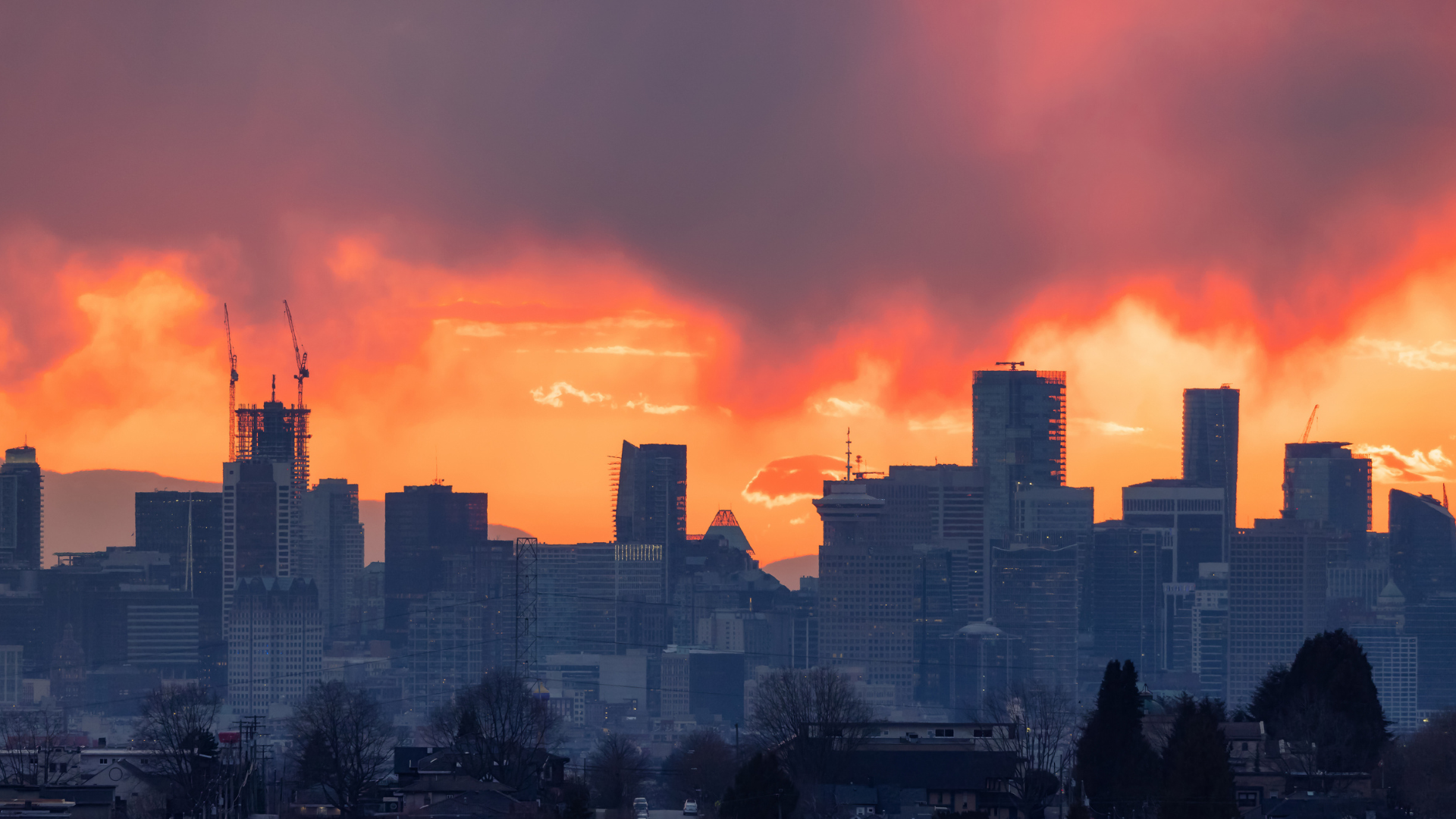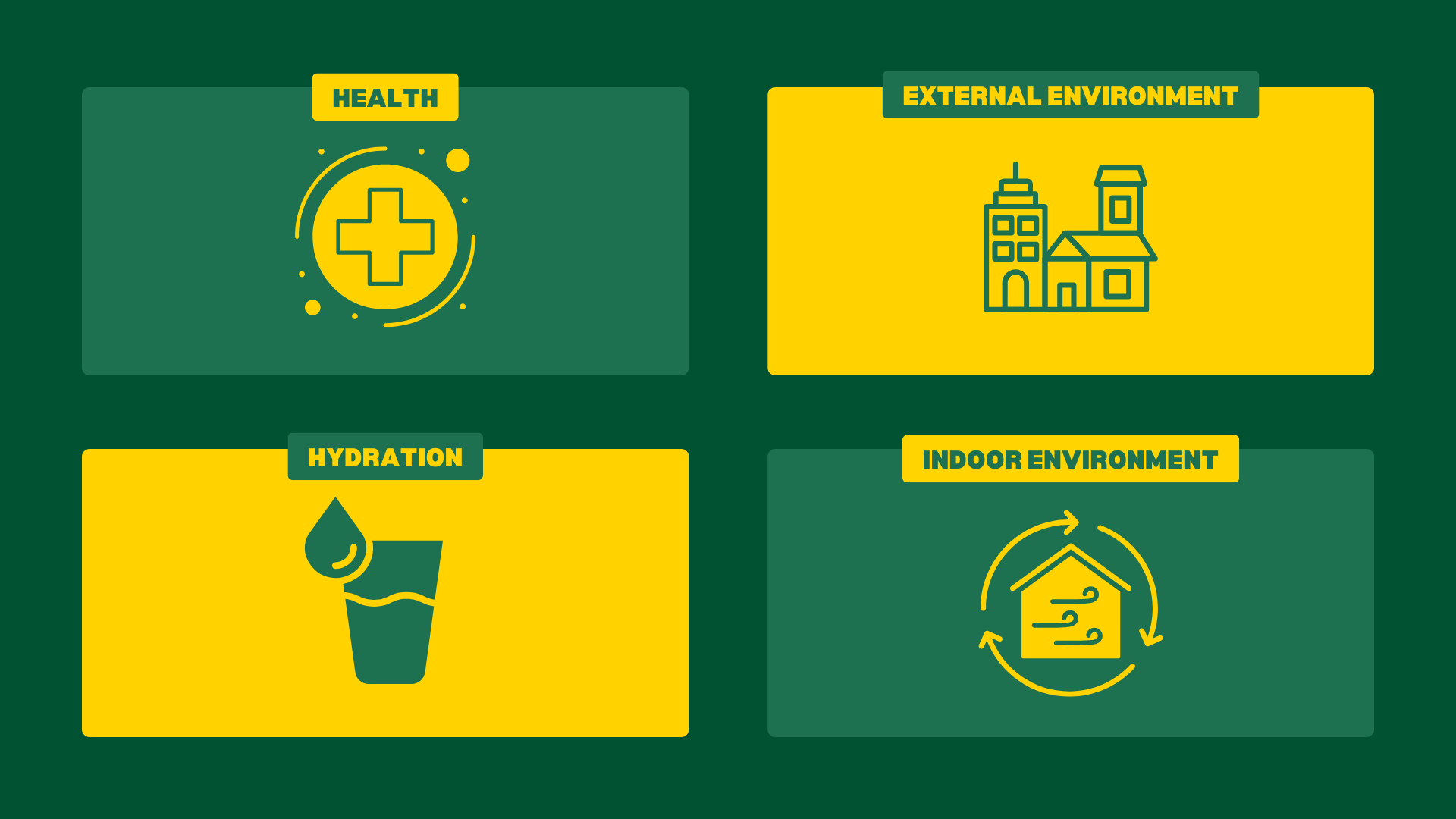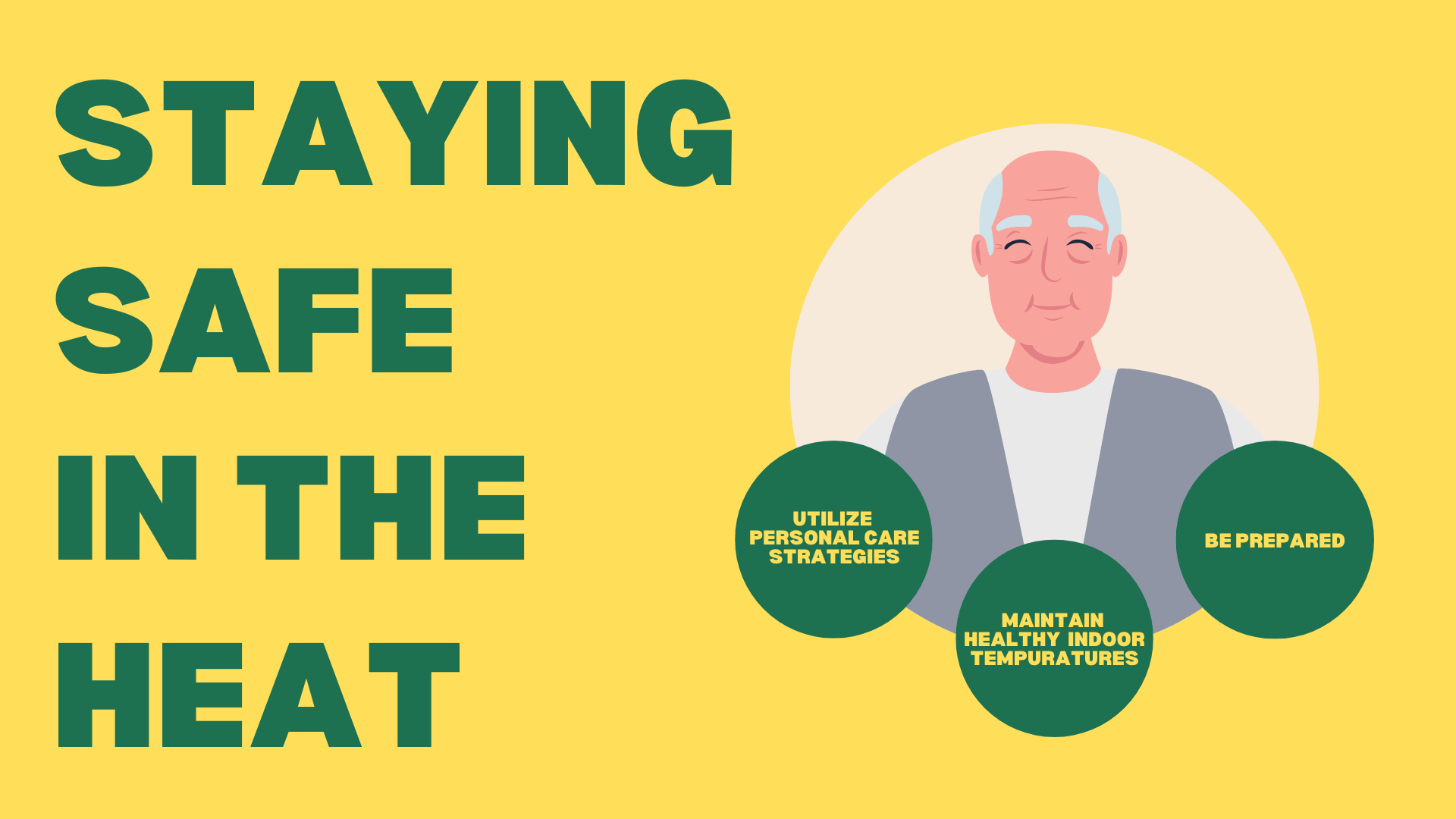Last weeks heatwave across southern British Columbia, saw temperatures rising 5-8°C above typical seasonal standards, with many BC communities reaching temperatures in the mid to high 30s [3].
Given expectations for this summer’s climate to continue the preceding trend of abnormally high temperatures, it’s important to be well informed [3].

Why is Heat Safety Important for Older Adults?
Vulnerability to heat is influenced by age more than any other factor, with individuals aged 65+ at the highest risk of experiencing the adverse health impacts of excessive heat [2].
As we age, thermoregulatory processes gradually slow, with the body’s effective ability to reduce internal temperature decreasing by approximately 4% each decade [2]. Prolonged heat exposure can result in deterioration of physiological processes and functional ability with the possibility of pathophysiological conditions (heat exhaustion, acute kidney injury, cardiovascular complications, heatstroke) and in extreme cases death[2].
Keeping Safe in the Heat: What are the Risks?

Dehydration
Dehydration accelerates the deterioration of the body’s heat dissipation mechanisms, increasing the physiological strain of prolonged heat exposure. As water availability in the body decreases, so does the body’s ability to produce sweat and disperse heat through increased blood flow to the skin (thermoregulatory processes, which are already diminished in older adults) [2]. Individuals on medications that impair thirst (selective serotonin reuptake inhibitors, angiotensin converting enzyme inhibitors, anti-Parkinson medication) or disturb the body’s natural fluid balance (diuretic medication) need to be particularly vigilant [2].
Underlying Conditions
Heat stress places strain on a multitude of physiological systems, making individuals with underlying cardiovascular, cerebrovascular, renal, respiratory, and neurological conditions or diabetes particularly vulnerable to heat[2]. Alongside and often compounded with age, individuals with underlying health conditions are at the highest risk of experiencing health complications under high heat exposure[2].
External Environment
The characteristics of your home’s external environment can significantly affect your level of heat exposure. Environmental factors such as heat-retaining materials like concrete or pavement, high-rise buildings, decreased vegetation, or human-generated heat as a result of traffic and industry all increase the risk of high temperatures[2]. With high-density urban areas averaging 2-4°C above rural areas, residents in larger metropolitan areas are particularly at risk[2].
Indoor Environment
Indoor temperatures pose a significant risk to older adults, with approximately 90% of heat-related deaths among older adults occurring within the home[2]. Understanding the characteristics and potential heat risks of your dwelling is essential for maintaining safe indoor temperatures.
Building Height
Without sufficient ventilation, hot air naturally rises, causing higher floors to become significantly warmer[2]. Temperatures can increase by an average of 0.5°C to 0.7°C with each additional storey, placing residents on upper floors at greater risk of adverse heat-related health effects[2].
Insulation and Building Materials
Homes with poor insulation retain heat and release it more slowly, making them more susceptible during periods of extreme heat[2]. Older buildings, which were not designed for higher temperatures, are particularly vulnerable[2]. Homes constructed with materials like vinyl paneling or wood siding are particularly at risk, as these materials are less resilient to heat and see some of the highest indoor temperatures[2].
Attic Insulation
Even in homes with relatively good insulation, attics are often overlooked. Poorly insulated attics can allow hot air to enter and accumulate, with recorded temperatures in some attics exceeding 50°C[2]. This heat can then transfer to other parts of the house through conduction and convection, raising the temperature inside the living areas[2].
Uncovered Windows and Direct Sunlight
Allowing windows and your home’s interior to be exposed to direct sunlight can lead to a 2-3°C increase in indoor temperatures[2].
Keeping Safe in the Heat: Strategies to Mitigate Overheating

Utilize Personal Care Strategies
Hydration
Staying hydrated is essential to mitigating adverse health effects and lowering the strain heat places on the body.
- Ensure you consume and have access to a consistent source of hydration[1].
- Avoid sugary or alcoholic beverages, which accelerate dehydration[1].
- Ask your physician if the medications you take affect your hydration or hydrating behaviours[1].
- If your physician has placed restrictions on your water intake or has prescribed you water pills, ask how much you should drink under high heat conditions[1].
Individual Cooling Strategies
Personal cooling techniques can be essential for staying safe during extreme heat and can serve as cooling alternatives if the power goes out.
- Cooling Baths
- Immersing parts or the whole body in cool water is a significant intervention for decreasing skin temperature, maintaining core body temperatures, and reducing thermoregulatory and cardiovascular strain[2].
- Cooling Towels
- Placing damp, cold towels on the skin can be a useful technique in lowering an individual’s heat strain. The primary cooling effects of this technique reside in water’s exceptional ability to conduct heat, transferring hotter skin temperatures to the towel[2]. It is important to maintain cool towel temperatures as cooling effects diminish as the towel moves towards body temperature[2].
- Ingestion of Cold Fluids
- Helpful in both providing hydration and mitigating increases in core body temperature. While useful, the cooling effects of cold fluid ingestion are short-lived and should not be solely relied upon[2].
- Air Conditioning
- Household air conditioning is the most effective strategy to mitigate indoor heat gain, maintain healthy temperatures, and protect against adverse health effects[2].
Are Electric Fans an Effective Personal Cooling Strategy?
The BC government advises that individuals do not rely on electric fans as their primary personal cooling strategy during high heat events[1].
Electric fans provide cooling by displacing the warm air surrounding an individual with fast-moving cool air, allowing for the transfer of heat away from the skin to the surrounding cooler air[2]. However, the positive cooling effects of electric fans only take place when the air temperature of a room is lower than that of the body (35°C). When air temperatures are higher than the body, electric fan use induces the opposite effect, displacing the cooler air around the skin with warmer air, accelerating heat gain[2].
Maintain Healthy Indoor Temperatures
The BC Government measures temperatures of 31°C and above as a danger to vulnerable populations[1]. Ensuring indoor temperatures stay within a healthly range is essential for staying safe in the heat.
Ventilation
It is important to properly ventilate the home to prevent the buildup of excessive heat indoors. The following ventilation practices should only be implemented when external air temperatures are lower than those indoors. The BC government advises applying ventilation practices during late evening and early morning hours[1].
- Cross-Ventilation
- Allowing air to flow into and out of a dwelling is a simple technique that can be used to dissipate the buildup of indoor heat. This can be done passively (leaving windows open) or mechanically facilitated by using fans or ventilation units to push cooler outdoor air indoors and hot internal air outwards [2]. Employing smaller input openings and larger outlets may help to improve the cooling effect by increasing air speeds[2].
- Buoyancy-Driven Ventilation
- In a multi-level dwelling, creating an opening on the ground floor and another on the top floor can facilitate a “chimney effect” in which cooler air enters the lower floor, dispersing the warm air, which then rises, and exits out this upper level outlet[2]. This can be further accelerated by fans or ventilation units.
Insulate Your Home Against Heat
- Limit Indoor Heat Gain from Sunlight
- External Window Shading
- Indoor Window Shading
- Install Under-Roof Insulation
- Under-roof installation of insulation can reduce attic temperatures by as much as 10°C, consequently reducing indoor ceiling temperatures[2].
Installation of Air Conditioning Systems
The BC government advises that at least one room of a dwelling contain an air conditioning unit during high heat conditions[1]. Air conditioning systems, such as window AC units or heat pumps, are the single most effective strategy for maintaining healthy indoor temperatures and protecting against heat-related health complications[2].
Be Prepared
- Recognise the potential personal and household risks that could elevate your exposure to heat[2].
- Identify the cool zones of your house. Consider modifying these areas to support sleeping and daily living[1].
- Identify cooling centres and spaces within your community. These areas could be: libraries, community centres, shopping malls, movie theatres, religious centres, or shaded green spaces and parks[1]. During high heat events, local governments may open emergency cooling centres[1].
- If you live alone, ask a friend or family member to check in on you throughout high-heat periods[1].
- Create a communication list of individuals you can contact. Ensure at least one contact is out-of-area in the case of local phone networks being overwhelmed[6].
- If your dwelling is at risk of experiencing excessive heat, plan to stay elsewhere[1].
- Obtain a digital thermometer to monitor for dangerously high indoor temperatures (31°C+)[1].
- Install an air conditioning unit or heat pump[5].
- Know when hot temperatures are expected. Regularly check local weather forecasts and warnings[5].
- Create an emergency plan→
Heatstroke
Heatstroke is a Medical Emergency
Heatstroke is a serious medical emergency indicating the body’s inability to regulate its core temperature[4]. Symptoms of heatstroke can include difficulty breathing, fast heart rate, nausea or vomiting, confusion, lapses in consciousness, red skin (even in the armpits), heavy sweating, a stoppage in sweating, or convulsions[4]. If you’re experiencing symptoms of heatstroke, call 911 and seek immediate medical care[1].
For more information on what to do in the event of heatstroke visit HealthLink BC – Emergency First Aid for Heatstroke →
Resources
EmergencyInfoBC
British Columbia’s online centre for providing official alerts and information regarding current emergencies in BC.
BC Centre for Disease Control
The BCCDC is a key provincial resource in providing comprehensive heat-related health and safety information.
BC Extreme Heat and Drought
Resources and tips for being properly prepared in the event of extreme heat or drought.
Health Canada | Staying Healthy in the Heat
Health Canada’s factsheet on heatstrokes, heat exhaustion, risk factors, and tips for staying safe in the heat.
EmergencyMapBC
An official interactive map with the locations of cooling centres, resources, and local emergencies.
Environment Canada
The Canadian government’s official online listing for regional weather event warnings and statements.
Make Your Plan
The BC government’s resource page for creating an emergency plan during extreme heat events.
HealthLink BC | Heatstroke First Aid
HealthLink BC’s overview and procedures for performing first aid in the event of heatstroke.
References
- BC GOV. (2025, March 18). Be prepared for extreme heat and drought. Province of British Columbia. https://www2.gov.bc.ca/gov/content/safety/emergency-management/preparedbc/know-your-hazards/severe-weather/extreme-heat
- Kenny, G. P., Tetzlaff, E. J., Journeay, W. S., Henderson, S. B., & O’Connor, F. K. (2024). Indoor overheating: A review of vulnerabilities, causes, and strategies to prevent adverse human health outcomes during extreme heat events. Temperature, 11(3), 203–246. https://doi.org/10.1080/23328940.2024.2361223
- The Weather Network. (2025, July 7). Extreme temperature contrast hits British Columbia and Alberta This Week. https://www.theweathernetwork.com/en/news/weather/forecasts/extreme-temperature-contrast-hits-british-columbia-and-alberta-this-week
- HealthLink BC. (2023, September 23). Emergency first aid for heatstroke. https://www.healthlinkbc.ca/healthwise/emergency-first-aid-heatstroke
- Health Canada. (2024, August 30). Staying Healthy in the Heat. Government of Canada. https://www.canada.ca/en/health-canada/services/publications/healthy-living/fact-sheet-staying-healthy-heat.html
- BC GOV. (2025, July 10). Make your emergency plan. Province of British Columbia. https://www2.gov.bc.ca/gov/content/safety/emergency-management/preparedbc/make-your-plan



